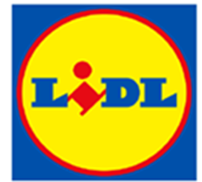
The UK High Court has held that Lidl’s rights in the Lidl logo were infringed by Tesco’s Clubcard Price(s) signs ([2023] EWHC 873 (Ch)). Specifically, the court made the following findings.
- Trade mark infringement – Lidl’s trade mark for the Lidl logo was infringed by Tesco’s Clubcard Price(s) signs, which took unfair advantage of Lidl’s reputation for low prices and damaged the distinctive character of Lidl’s logo.
- Passing off – Consumers were mistakenly believing that Tesco’s Clubcard prices matched Lidl’s prices or the products were equivalent in value.
- Copyright infringement – Copyright subsists in the Lidl logo and this was copied by Tesco in creating their Clubcard Price(s) signs.
The judgment consolidated this infringement claim with Tesco’s counterclaim for invalidity of various of Lidl’s trade marks covering the wordless background of the Lidl logo (the “Wordless Mark(s)”). The judge held that certain of these Wordless Marks were invalid for bad faith. However, Lidl’s key trade mark for the Lidl Logo including the word LIDL (the “Mark with Text”) was valid and so Tesco remained liable for trade mark infringement.
On copyright subsistence, the judge held that the Mark with Text is an artistic work, failing within the sub-category of “graphic works”. Tesco had objected to copyright subsistence on the basis that the Mark with Text was not original, having been created in stages and being too simple. However, the judge found that the Mark with Text, by its combination of text, colours and shapes involved sufficient skill, labour and creative freedom to satisfy the requirement for originality.
Lidl’s marks and Tesco’s signs are shown below:
| The Lidl logo
(the / Lidl’s “Mark with Text”) |
Lidl’s logo absent text (the / Lidl’s “Wordless Mark”) | Tesco’s Clubcard Price(s) signs (the / Tesco’s “CCP Signs”) |
 |
 |

|
You might be wondering why you’re still seeing Tesco’s Clubcard Price(s) signs (the “CCP Signs”) in Tesco stores. While a final injunction against such use has been granted in a consequentials hearing ([2023] EWHC 1517 (Ch)), that injunction is stayed pending the outcome of any appeals to the Court of Appeal.
In September 2023, the Court of Appeal allowed appeals, apparently from both parties. These are currently expected to be heard by September / October of 2024. The precise details of what is being appealed is not yet known.
The parties
The parties are well-known competing supermarkets in the UK.
Lidl is described in the judgment as a “discounter” supermarket: it focuses on own-branded products and a “more curated selection of goods thus enabling greater control over price” (Paragraph [51]). Another example of a “discounter” supermarket is Aldi.
Tesco is descried as a “mid-tier” supermarket: it has a “selection of own-brand and third party products at a range of price points”(Paragraph [51]). Other “mid-tier” supermarkets are Sainsbury’s, Asda, Morrisons and Co-Op.
The background
Lidl opened its first UK store in 1994 and has always operated under the Mark with Text.
In 1995, Tesco launched its “Clubcard” loyalty scheme to reward customers for shopping at Tesco. As part of this scheme, in September 2020, Tesco introduced the Clubcard Prices promotion: Tesco Clubcard holders were given discounts at the point of sale on certain products. Those discounts were identified using Tesco’s CCP Signs, which either stated a price figure alongside “Clubcard Price” or merely read “Clubcard Prices”.
Lidl alleged that Tesco’s CCP Signs infringed various rights in Lidl’s Mark with Text and Lidl’s Wordless Mark.
Trade mark infringement
Lidl relied on various registrations for each of: the Mark with Text, and the Wordless Mark. The judgment focused on the Mark with Text. The judge considered that the correct comparison was between the Lidl marks on the one hand, and Tesco’s CCP Signs with the text they comprised on the other, rather than with Tesco’s CCP Signs absent their text.
In short, Lidl’s case was as follows, relying on section 10(3) of the UK’s Trade Marks Act 1994 (“TMA”):
- consumers seeing Tesco’s CCP Signs would link them to Lidl’s brand and reputation;
- those consumers would then believe that Tesco’s prices are being said to be comparable to Lidl’s low prices and/or price-matched to Lidl; and
- this would: (1) give Tesco an unfair advantage, and/or (2) be detrimental to the distinctive character of Lidl’s mark (which was being a low-priced brand), by suggesting Tesco was price-matched to Lidl.
Similarity
The judge noted that both Lidl’s Mark with Text and Tesco’s CCP Signs comprised “background components made up of a yellow circle within a blue square” and “writing in the centre of the blue circle”, presumably meaning yellow circle in latter quote (Paragraph [87]). While she referred to the contrasting text as an important point of difference, she held that this did not extinguish the “strong impression of similarity conveyed by their backgrounds” (Paragraph [91]).
On the whole, the judge held the overall impression in the mind of the average consumer was of similarity. There was a lot of support for this finding in the evidence, including emails between members of Tesco’s internal team, which stated: “Price tiles: The yellow circle inside the blue tile looks a bit like a Lidl ad” (Paragraph [92ii)]).
Link
The judge found that the evidence was sufficient to demonstrate that the average consumer encountering the CCP Signs at the date of launch of the Clubcard Price campaign “would draw a link between the Uses of the CCP Signs and the Mark with Text” (Paragraph [147]).
Specifically, the judge referred to numerous examples of references to the similarity between the signs and of consumers referring to Lidl upon seeing Tesco’s CCP Signs, including in the following evidence: research reports, consumer surveys, Lidl’s member-of-the-public witnesses, and a document called the “Lidl Vox Populi” which comprised statements from members of the public, such as on Twitter (as it was named then).
Injury (detriment and unfair advantage)
While the judge rejected Lidl’s claim of subjective intent and deliberate “coat tailing”, she recognised this was not fatal to an infringement claim under section 10(3) of the TMA. Instead, the court needed to consider, regardless of Tesco’s intention, whether Tesco’s use of the CCP Signs was likely to have resulted in a ‘subtle but insidious’ transfer of image’ from Lidl’s Marks to the CCP Signs in the minds of some consumers” (Paragraph [157]).
As regards demonstrating “detriment”, applying the case law, the judge required actual “evidence of a change in economic behaviour since [the launch of the Clubcard Prices campaign in 2020]” (Paragraph [158]), while appreciating this can be difficult to obtain. Given the Tesco’s Clubcard Prices had launched well over two years prior to trial, she did not consider it sufficient for Lidl to contend that there was merely a serious likelihood of a change in economic behaviour of the average consumer in the future.
The judge accepted Lidl’s evidence of a campaign by Lidl designed to show consumers that Tesco’s Clubcard prices were not in fact price-matched to those of Lidl. She noted the specific steps Lidl had been “forced to take” in response to Tesco’s extensive use of the CCP Signs to prevent any consequential dilution of Lidl’s reputation as a low cost discounter, in the form of “corrective advertising”(Paragraph [160] and [170]). This assisted in demonstrating detriment to the distinctive character of the Mark with Text.
Regarding unfair advantage, relying on her findings on similarity and link above, the judge found that Tesco had taken unfair advantage of the distinctive reputation residing in the Mark with Text for low price (discounted) value. While the evidence did not demonstrate that was Tesco’s intention, it did support that being the objective effect of the creation of the link.
It is worth highlighting the nuance here. The judge did find that Tesco intended, via its use of the CCP Signs, to convey value to consumers and thereby influence the economic behaviour of shoppers. However, that is not the same as a specific intention to free-ride on Lidl’s specific reputation (see Paragraph [176]). Essentially, Tesco were more easily and effective able to convey value in their Clubcard Prices promotion (which was their intention) by reason of the connection between the CCP Signs and Lidl’s Mark with Text (which was not their intention, but was the objective effect).
Conclusion on trade mark infringement
Accordingly, Tesco’s use of the CCP Signs infringed Lidl’s Mark with Text under section 10(3) of the TMA. The judge found the “position as to infringement is the same” for Lidl’s Wordless Mark (Paragraph [193]).
Trade mark validity – the Wordless Mark
Tesco’s counterclaim of invalidity was only in relation to the Wordless Mark. The grounds were: non-use, lack of distinctive character and bad faith.
Non-use
The judge found that Lidl’s use of the Mark with Text was sufficient to establish use of the Wordless Mark, accordingly the non-use ground failed.
Lack of distinctive character
Tesco argued that the Wordless Mark was a decorative background, and not distinctive of Lidl. However, the evidence indicated that the Wordless Mark on its own had indeed “acquired the ability to demonstrate exclusive origin” (Paragraph [211]), and so the Wordless Mark had distinctive character. In particular, the judge referred to a survey carried out on behalf of Lidl whereby 73% of participants mentioned Lidl only upon being shown the Wordless Mark and asked: “What do you think this image is?”.
Bad faith
The judge found that when Lidl originally filed the first application for the Wordless Mark in 1995 it did not intend to use it as a trade mark, but rather as a “legal weapon”. This was despite the court’s finding that Lidl had in fact used the Wordless Mark and it had distinctive character. However, Lidl was unable to demonstrate a plausible explanation of its objective and commercial logic pursued by the application for the Wordless Mark; as such, it was found to be filed in bad faith.
Subsequent registrations of the Wordless Mark were also found to be invalid for bad faith. The judge noted that these subsequent registrations covered goods/services already covered by previous Wordless Mark registrations. As such, the judge found that they were filed in part to evergreen the Wordless Mark and avoid sanctions for five years’ non-use which amounts to an “abuse of the trade mark system” (Paragraph [256]).
Copyright
Lidl claimed copyright in both the Mark with Text and the Wordless Mark. Tesco denied copyright subsisted in either.
Interestingly, the judge found that, given the Wordless Mark has not be used other than as a background, there was nothing to suggest that Tesco had seen the Wordless Mark. Accordingly, any copying by Tesco could only have occurred in relation to Lidl’s Mark with Text. For that reason, copyright subsistence and infringement was primarily assessed in relation to the Mark with Text.
Subsistence
It was common ground that the Mark with Text was capable of being a “graphic work”, which is a subset of the “artistic works” category. A “graphic work” includes “any painting, drawing, diagram, map, chart or plan” according to section 4(2)(a) of the UK’s Copyright, Designs and Patents Act 1988.
The dispute centred around originality; the court recognised the appropriate test is whether the Mark with Text contains elements which are the expression of the intellectual creation of the author of the work. Tesco’s objection to originality in the Mark with Text was summarised by the judge as being that the “combination consists of insufficient skill and labour because it is too simple” (Paragraph [288]). This was rejected by the judge for two reasons.
Firstly, the judge noted that the artistic quality may not have been “high”, but referred to the fact that a low level of artistic quality, or a simplistic design does not preclude a work being considered original.
Secondly, she pointed to the fact that it was the combination of elements that was original. In doing so, she referred to Tesco’s own evidence on their creation of the CCP Signs, which supported that such a process involved time, labour and creative freedom. Accordingly, it was found that “bringing together the Lidl text with the yellow circle and blue background was an act which involved skill and labour” (Paragraph [288]).
For those reasons, the judge found that the Mark with Text “involves the exercise of intellectual creation involving the expression of free choice” and was thus original (Paragraph [290]).
Infringement
On infringement, Tesco accepted that they were well aware of Lidl’s Mark with Text. The judge found that the similarities were sufficiently close to be more likely a result of copying than coincidence and so it was for Tesco to explain those similarities.
Tesco’s evidence on this point was criticised by the judge as appearing to have been “designed to obscure the involvement” of an external design agency (Paragraph [309]). Her finding on the evidence was that this agency copied the background to the Mark with Text as a consequence of the brief they were provided with from Tesco. Lidl successfully argued that the part copied (the blue background with the yellow circle) formed a substantial part of the copyright work (the Mark with Text), and so Tesco was held liable for copyright infringement.
Conclusion
A long judgment often indicates a lot of evidence, or a complex legal case. Here, it was arguably both.
From a trade mark perspective, Lidl’s case as put forward was not particularly straightforward or conventional: they claimed passing off as to equivalence and 10(3) TMA infringement requiring that Lidl demonstrate detriment they suffered or an unfair advantage accrued to Tesco through Tesco’s use of the CCP Signs.
However, that was what the facts required. It was quite clear that consumers were unlikely to see Tesco’s CCP Signs and believe they were shopping in a Lidl, as such, confusion as to origin was not really an option.
What seemed to work strongly in Lidl’s favour was the evidence in terms of quality and quantity. The judge was able to point to numerous clear examples of consumers forming a link between Tesco’s signs and Lidl’s marks. That evidence took the form of customer surveys conducted by Lidl, internal Tesco communication, market research reports and publicly available consumer statements (the Lidl Vox Populi). However, it also included two member-of-the-public witnesses called by Lidl, whose evidence covered their responses to seeing Tesco’s CCP Signs.
In a context where there is strong evidence that Lidl had educated the public that their brand was well-recognised and really meant something – namely: low prices / good value – a finding of 10(3) TMA infringement followed more easily.
One evidential challenge Lidl faced was on demonstrating detriment to the distinctive character of their mark. Given the CCP Signs were being used for up to 2 years up to trial, it was not enough for Lidl to rely on merely potential future detriment. From a practical perspective, it is worth remembering to keep collating evidence throughout and before the litigation process. It is also worth noting that Lidl’s own steps taken to prevent such detriment (in the form of corrective advertising) was helpful evidence in support of a detriment suffered.
From a copyright perspective, the decision is reassuring to brand owners with somewhat simple logos, or parts of simple logos, which they may previously have considered would not be protectable by copyright or at least would only rely on their trade mark rights.
While it is established that simplistic designs are not precluded from copyright protection, given the commonplace nature of the elements one might have expected at the least a very narrow scope of protection for the Lidl logo / Mark with Text.
The judge found Lidl’s Mark with Text to be a copyright work, since “bringing together the Lidl text with the yellow circle and blue background was an act which involved skill and labour” (Paragraph [288]). However, by then deciding that the yellow circle and blue background was a substantial part of that work, the impact is that Lidl can potentially prevent third parties copying just that part. This seems to give a wide scope of protection for Lidl.
It is worth noting that Tesco’s own evidence of their extensive efforts in designing the CCP Signs was supportive of a finding of copyright subsistence in Lidl’s logo: it assisted in demonstrating the creative effort going into even fairly simple logo designs.
________________________
To make sure you do not miss out on regular updates from the Kluwer Copyright Blog, please subscribe here.



